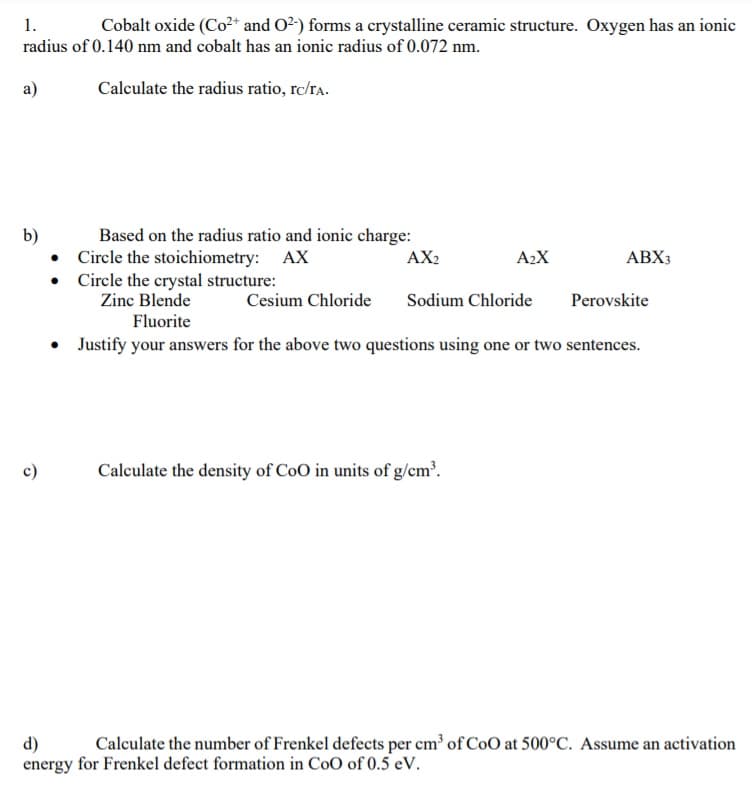1. Cobalt oxide (Co²* and O²) forms a crystalline ceramic structure. Oxygen has an ionic radius of 0.140 nm and cobalt has an ionic radius of 0.072 nm. a) Calculate the radius ratio, rc/ra. b) Based on the radius ratio and ionic charge: Circle the stoichiometry: AX • Circle the crystal structure: AX2 A2X ABX3 Zinc Blende Cesium Chloride Sodium Chloride Perovskite Fluorite • Justify your answers for the above two questions using one or two sentences. Calculate the density of CoO in units of g/cm³.
1. Cobalt oxide (Co²* and O²) forms a crystalline ceramic structure. Oxygen has an ionic radius of 0.140 nm and cobalt has an ionic radius of 0.072 nm. a) Calculate the radius ratio, rc/ra. b) Based on the radius ratio and ionic charge: Circle the stoichiometry: AX • Circle the crystal structure: AX2 A2X ABX3 Zinc Blende Cesium Chloride Sodium Chloride Perovskite Fluorite • Justify your answers for the above two questions using one or two sentences. Calculate the density of CoO in units of g/cm³.
Chemistry
10th Edition
ISBN:9781305957404
Author:Steven S. Zumdahl, Susan A. Zumdahl, Donald J. DeCoste
Publisher:Steven S. Zumdahl, Susan A. Zumdahl, Donald J. DeCoste
Chapter10: Liquids And Solids
Section: Chapter Questions
Problem 90E: The structures of another class of ceramic, high-temperature superconductors are shown in figures...
Related questions
Question

Transcribed Image Text:1.
Cobalt oxide (Co2+ and O²-) forms a crystalline ceramic structure. Oxygen has an ionic
radius of 0.140 nm and cobalt has an ionic radius of 0.072 nm.
a)
Calculate the radius ratio, rc/ra.
b)
Based on the radius ratio and ionic charge:
Circle the stoichiometry: AX
• Circle the crystal structure:
Zinc Blende
AX2
A2X
ABX3
Cesium Chloride
Sodium Chloride
Perovskite
Fluorite
• Justify your answers for the above two questions using one or two sentences.
Calculate the density of CoO in units of g/cm'.
Calculate the number of Frenkel defects per cm' of CoO at 500°C. Assume an activation
d)
energy for Frenkel defect formation in CoO of 0.5 eV.
Expert Solution
This question has been solved!
Explore an expertly crafted, step-by-step solution for a thorough understanding of key concepts.
This is a popular solution!
Trending now
This is a popular solution!
Step by step
Solved in 5 steps with 1 images

Knowledge Booster
Learn more about
Need a deep-dive on the concept behind this application? Look no further. Learn more about this topic, chemistry and related others by exploring similar questions and additional content below.Recommended textbooks for you

Chemistry
Chemistry
ISBN:
9781305957404
Author:
Steven S. Zumdahl, Susan A. Zumdahl, Donald J. DeCoste
Publisher:
Cengage Learning

Chemistry: An Atoms First Approach
Chemistry
ISBN:
9781305079243
Author:
Steven S. Zumdahl, Susan A. Zumdahl
Publisher:
Cengage Learning


Chemistry
Chemistry
ISBN:
9781305957404
Author:
Steven S. Zumdahl, Susan A. Zumdahl, Donald J. DeCoste
Publisher:
Cengage Learning

Chemistry: An Atoms First Approach
Chemistry
ISBN:
9781305079243
Author:
Steven S. Zumdahl, Susan A. Zumdahl
Publisher:
Cengage Learning


Chemistry by OpenStax (2015-05-04)
Chemistry
ISBN:
9781938168390
Author:
Klaus Theopold, Richard H Langley, Paul Flowers, William R. Robinson, Mark Blaser
Publisher:
OpenStax

Chemistry for Engineering Students
Chemistry
ISBN:
9781337398909
Author:
Lawrence S. Brown, Tom Holme
Publisher:
Cengage Learning

Chemistry & Chemical Reactivity
Chemistry
ISBN:
9781133949640
Author:
John C. Kotz, Paul M. Treichel, John Townsend, David Treichel
Publisher:
Cengage Learning